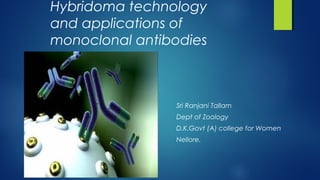
Monoclonal antibodies
- 1. Hybridoma technology and applications of monoclonal antibodies Sri Ranjani Tallam Dept of Zoology D.K.Govt (A) college for Women Nellore.
- 2. What are antibodies…. An antibody is a protein used by the immune system to identify and neutralize foreign objects like bacteria and viruses. Each antibody recognizes a specific antigen unique to its target. Monoclonal antibodies (mAb) are antibodies that are identical because they were produced by one type of immune cell, all clones of a single parent cell. ( Clone is a group of genetically identical cells.) Polyclonal antibodies are antibodies that are derived from different cell lines.
- 3. Differences between monoclonal and polyclonal antibodies
- 4. Hybridoma Technology 1975, Georges Köhler and Cesar Milstein - awarded Nobel Prize in1984
- 5. In 1975, Kohler and Milstein first fused lymphocytes with myeloma cells to produce a cell line which was both immortal and a producer of specific antibodies. The two scientists were awarded the Nobel Prize for Medicine in 1984 for the development of this "hybridoma." The value of hybridomas to the field was not truly appreciated until about 1987, when MAbs were regularly produced in rodents for diagnostics.
- 8. STEPS : 1.Immunization 2. Cell fusion 3. Selection of hybridomas 4. Screening the products 5. Cloning and propagation 6. Characterization and storage
- 9. PRODUCTION OF MONOCLONAL ANTIBODY Step 1: - Immunization Of Mice & Selection Of Mouse Donor For Generation Of Hybridoma cells HYBRIDOMA TECHNOLOGY ANTIGEN ( Intact cell/ Whole cell membrane/ micro-organisms ) + ADJUVANT (emulsification) Ab titre reached in Serum Spleen removed (source of cells)
- 11. PRODUCTION OF MONOCLONAL ANTIBODY Step 3: - Preparation of Myeloma cells with defective HGPRT Gene . HYBRIDOMA TECHNOLOGY Myeloma Cells HGPRT- (Hypoxanthin Guanine phosphoribosyltransferase)
- 12. PRODUCTION OF MONOCLONAL ANTIBODY Step 4: - Fusion of Myeloma Cells with Immune Spleen Cells & Selection of Hybridoma Cells HYBRIDOMA TECHNOLOGY FUSION PEG MYELOMA CELLSSPLEEN CELLS HYBRIDOMA CELLS ELISA PLATE Feeder Cells Growth Medium HAT Medium 1. Plating of Cells in HAT selective Medium 2. Scanning of Viable Hybridomas
- 17. • Mammalian cells can synthesize nucleotides by two different pathways: • 1. Denovo Pathway :Aminopterin blockes the DNA synthesis • 2. Salvage Pathway: The enzymes catalyzing the salvage pathway include hypoxanthine-guanine phosphoribosyl tranferase (HGPRT). • Myeloma cells lack HGPRT. That’s why can not synthesize the nucleotides. • HAT is the selective medium which contains Hypoxanthin, Aminopterin and Thymidine.
- 18. Pathways for nucleotide synthesis
- 23. Application Of MAbs: Monoclonal antibodies are proving to be very useful as diagnostic, imaging, and therapuetic reagents in clinical medicine. Many monoclonal antibody diagnostic reagents now available are products for detecting pregnancy, diagnosing numerous pathogenic microorganisms, measuring blood levels of various drugs, and detecting antigens shed by certain tumors.
- 24. Monoclonal – Diagnostic use A monoclonal antibody can be used to detect pregnancy only 14 days after conception. Other monoclonal antibodies allow rapid diagnosis of hepatitis, influenza, herpes, streptococcal, and Chlamydia infections. They can be used to detect for the presence and quantity of this substance, for instance in a Western blot test (to detect a substance in a solution) or an immunofluorescence test. Monoclonal antibodies can also be used to purify a substance with techniques called immunoprecipitation and affinity chromatography.
- 25. Pregnancy Tests A pregnant woman has the hormone human chorionic gonadotrophin (HCG) in her urine. Monoclonal antibodies to HCG have been produced. These have been attached to enzymes which can later interact with a dye molecule and produce a colour change.
- 26. HIV DETECTION a)HIV antigen is attached to the plate. b)Patients serum passed over the plate. Any HIV antibody in the patients serum will attached to the antigen already on the plate. c)A second antibody which is specific to the HIV antibody is passed over the plate. This antibody will attach to the concentrated HIV antibody on the plate. This second antibody has an enzyme attached to its structure. d)Chromagen dye is passed over the complex of concentrated HIV antibody/conjugated antibody. e)The enzyme will turn the chromagen to a more intense colour. The more intense the colour, the greater the HIV antibody level. This would be the a positive result for a HIV test.
- 27. Treatment of Cancer Cancer cells carry specific tumour-associated antigens (TAA) on their plasma membrane. Monoclonal anti-TAA antibodies have been produced. Drugs which kill tumour cells or inhibit key proteins in tumour cells are attached to monoclonal anti-TAA antibodies. Cancer cells are specifically targeted, avoiding damage to healthy host cells.
- 29. Any questions ? Thank you !!!